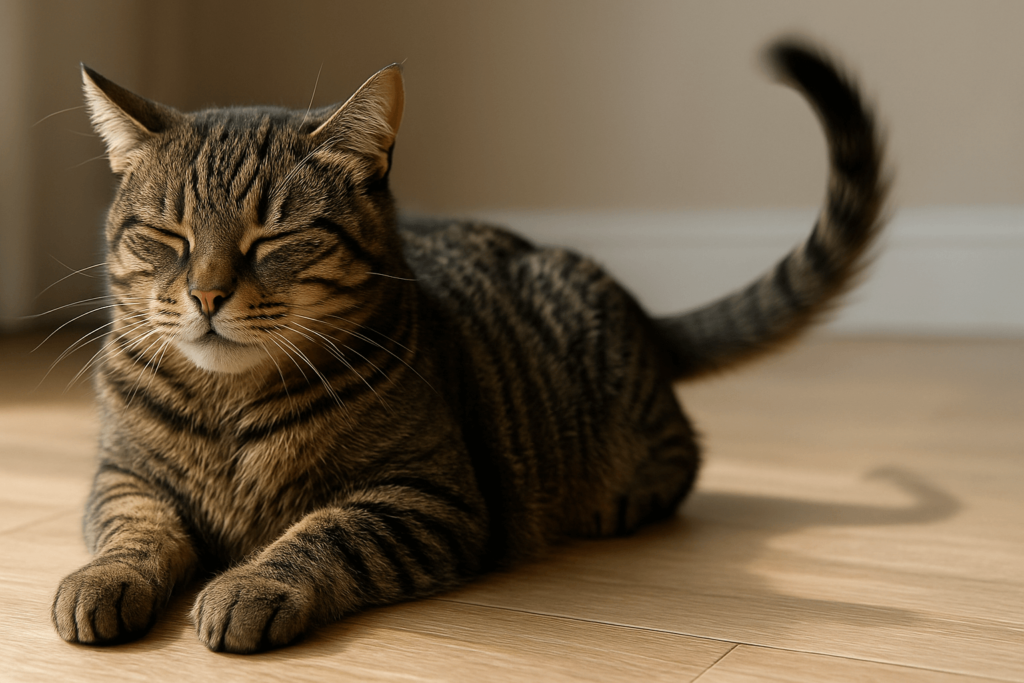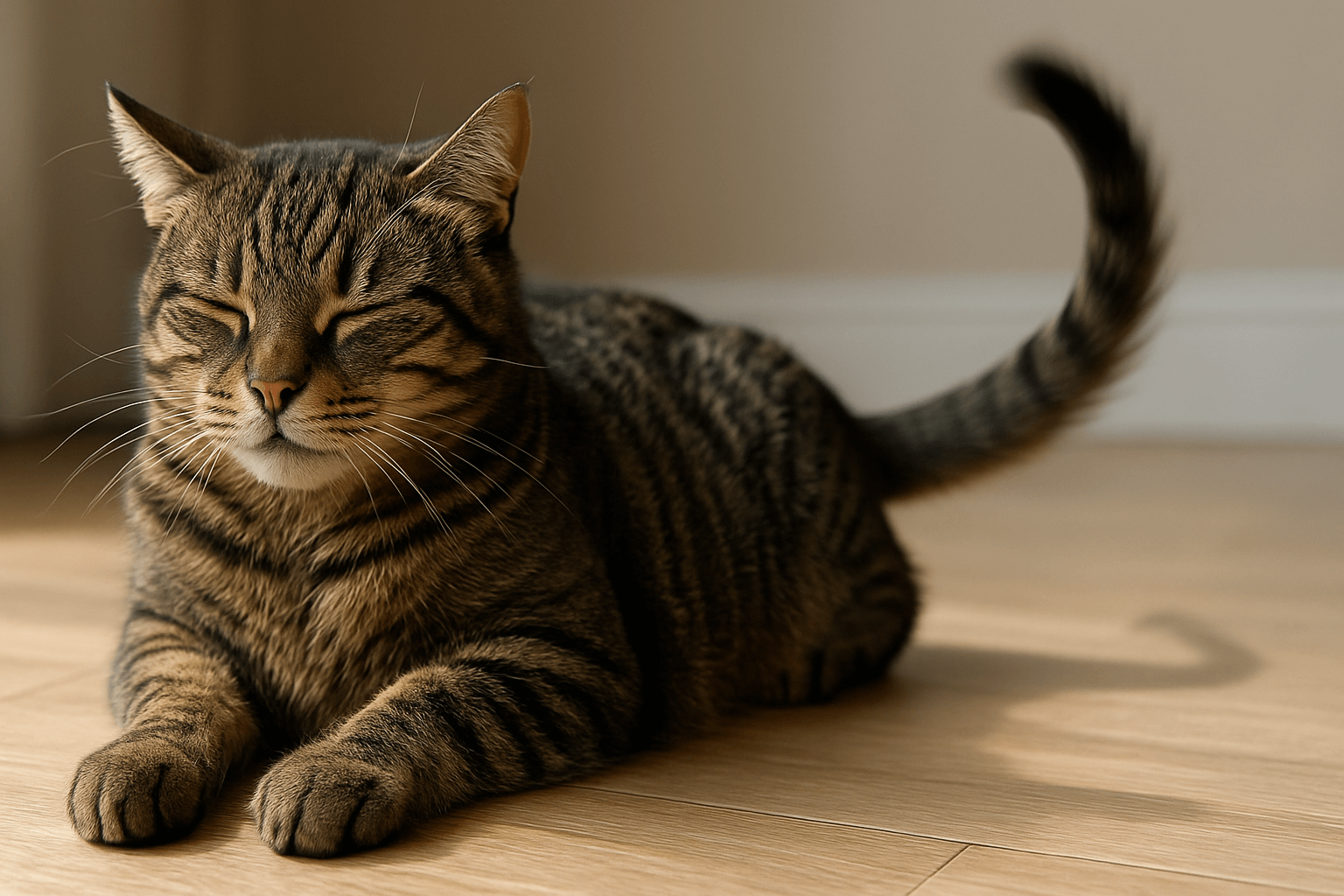Understanding Cat Tail Spasms
A cat’s tail is more than just a cute appendage—it’s a vital tool for communication, balance, and expressing emotions. However, when your feline friend experiences a sudden or unusual tail spasm, it can leave you concerned and wondering what might be wrong. Tail spasms in cats can range from harmless twitches to signs of underlying health issues. Whether caused by excitement, stress, or a medical condition, understanding the reasons behind these movements is key to ensuring your cat’s well-being. In this blog post, we’ll explore everything you need to know about cat tail spasms, including potential causes, symptoms, and how to address them effectively.
Common Causes of Cat Tail Spasms
Cat tail spasms can occur for a variety of reasons, ranging from normal behavior to potential health concerns. Identifying the cause is essential to determine whether intervention is needed.
Excitement or Anticipation:
Cats often twitch their tails when they’re excited or focused on something, such as prey during playtime. These spasms are usually brief and harmless.Stress or Anxiety:
A tense or agitated cat may experience tail spasms as a physical manifestation of their emotional state. Look for other signs of stress, like flattened ears or dilated pupils.Pain or Discomfort:
Tail spasms can indicate pain in the tail itself or elsewhere in the body. For example, an injury or nerve issue might trigger involuntary movements.Feline Hyperesthesia Syndrome (FHS):
This neurological condition can cause exaggerated tail movements, skin rippling, and sensitivity to touch. It’s important to consult a vet if you suspect FHS.Normal Muscle Twitches:
Just like humans, cats can experience occasional muscle twitches that are not a cause for concern. These are typically random and infrequent.
By recognizing these common causes, you can better assess whether your cat’s tail spasms are normal or warrant further investigation.

Signs That Your Cat’s Tail Spasms May Be Serious
While some tail spasms are harmless, others may indicate an underlying issue that requires attention. Watch for these warning signs that could point to a more serious problem.
Excessive or Prolonged Twitching:
If your cat’s tail spasms last for an extended period or occur frequently, it could signal a neurological issue or chronic condition.Biting or Chewing the Tail:
Cats who excessively bite or chew their tails may be experiencing pain, irritation, or even a flea infestation.Changes in Behavior:
Noticeable changes in your cat’s mood, appetite, or activity level alongside tail spasms may indicate discomfort or illness.Visible Swelling or Injury:
Inspect your cat’s tail for signs of trauma, such as swelling, cuts, or hair loss, which could explain the spasms.Loss of Balance or Coordination:
If your cat struggles to maintain balance or seems uncoordinated, it could suggest a spinal or nerve-related issue affecting the tail.
Being vigilant about these signs ensures you can seek veterinary care promptly if needed.
Check this guide 👉Understanding Cat Tail Bite Wounds: Best 7 Expert Tips!
Check this guide 👉Are Cat Tails Sensitive? Best 7 Expert Tips!
Check this guide 👉Cat Tail Emotions: Best 7 Expert Tips!
Potential Causes of Tail Spasms | When to See a Veterinarian |
|---|---|
Excitement or anticipation | Frequent or prolonged spasms |
Stress or anxiety | Biting or chewing the tail excessively |
Pain or injury | Visible swelling or trauma to the tail |
Feline Hyperesthesia Syndrome (FHS) | Changes in behavior or coordination |
Normal muscle twitches | Loss of balance or mobility |
How to Help Your Cat Manage Tail Spasms
If your cat is experiencing tail spasms, there are steps you can take to provide comfort and support. Here are some practical tips to help manage the situation.
Observe Closely:
Pay attention to when and where the spasms occur. Documenting patterns can help your vet diagnose any underlying issues.Reduce Stressors:
Create a calm environment by minimizing loud noises, unfamiliar guests, or other stress triggers that might upset your cat.Provide Enrichment:
Engage your cat with interactive toys and activities to distract them from tail-focused behaviors and reduce boredom.Inspect for Fleas or Irritation:
Check your cat’s tail and hindquarters for fleas, mites, or skin irritations that could cause discomfort and spasms.Consult a Veterinarian:
If the spasms persist or worsen, schedule a vet visit to rule out conditions like nerve damage, arthritis, or FHS.
Taking proactive measures can alleviate your cat’s discomfort and prevent minor issues from escalating into major problems.
Preventing Future Tail Spasms in Cats
Prevention is always better than cure when it comes to your cat’s health. By adopting certain habits and routines, you can minimize the risk of recurring tail spasms.
Regular Grooming:
Keep your cat’s coat clean and free of tangles to prevent irritation and reduce the likelihood of tail-focused behaviors.Balanced Nutrition:
Ensure your cat receives a diet rich in essential nutrients to support overall health, including strong muscles and nerves.Routine Vet Checkups:
Schedule regular veterinary visits to catch and address any health concerns before they escalate.Safe Play Environment:
Avoid rough play that could injure your cat’s tail or spine, leading to potential spasms.Monitor for Behavioral Changes:
Stay alert to shifts in your cat’s behavior, as early detection can make treatment more effective.
By prioritizing prevention, you can help keep your cat happy, healthy, and spasm-free.
Additional Tips for Managing Tail Spasms
Managing tail spasms involves more than just addressing immediate symptoms—it’s about creating a supportive environment for your cat. Here are additional tips to consider.
Use Calming Products:
Pheromone diffusers or sprays can help soothe anxious cats and reduce stress-related spasms.Limit Sudden Movements:
Avoid startling your cat with loud noises or abrupt actions, as these can trigger tail twitching.Encourage Restful Sleep:
Ensure your cat has a quiet, cozy space to rest, promoting relaxation and reducing tension.Introduce Gentle Massage:
Lightly massaging your cat’s back and tail can relieve muscle tension and improve circulation.Monitor Diet for Allergies:
Food allergies can sometimes cause skin irritation, leading to tail-focused behaviors. Consult your vet if you suspect dietary issues.
Implementing these strategies can enhance your cat’s comfort and reduce the frequency of spasms.
Understanding the Role of the Tail in Cat Communication
A cat’s tail plays a crucial role in expressing emotions and intentions. Recognizing its communicative functions helps you interpret tail spasms more accurately.
Upright Tail:
A raised tail signifies confidence and contentment, while slight twitches may indicate curiosity.Puffed-Up Tail:
A puffed tail often reflects fear or aggression, and spasms may accompany heightened emotions.Tucked Tail:
A tucked tail suggests submission or fear, and spasms here could indicate stress or discomfort.Whipping Motion:
Rapid whipping motions typically signal irritation or anger, which might escalate into spasms.Gentle Swishing:
Slow, deliberate swishes may show focus or mild annoyance, depending on the context.
Understanding these signals deepens your bond with your cat and aids in identifying abnormal behaviors.
When to Consider Alternative Therapies
If traditional treatments don’t fully address your cat’s tail spasms, alternative therapies might offer additional relief. Explore these options under veterinary guidance.
Acupuncture:
This ancient practice can help alleviate nerve pain and muscle tension in cats.Physical Therapy:
Tail exercises and stretches may improve mobility and reduce spasms caused by injury.Herbal Supplements:
Certain herbs, like chamomile or valerian root, may have calming effects, though always consult your vet first.Laser Therapy:
Low-level laser treatments can promote healing and reduce inflammation in affected areas.Behavioral Training:
Working with a feline behaviorist can help redirect harmful habits linked to tail spasms.
Alternative therapies can complement conventional treatments, providing holistic care for your cat’s needs.
Frequently Asked Questions About Cat Tail Spasms
Are tail spasms in cats normal?
Occasional tail spasms are usually normal, but frequent or intense spasms may indicate an underlying issue.
What should I do if my cat’s tail is twitching constantly?
Consult your veterinarian to rule out conditions like Feline Hyperesthesia Syndrome or nerve damage.
Can fleas cause tail spasms?
Yes, fleas or skin irritations near the tail can lead to excessive twitching or biting.
Is it safe to touch my cat’s tail during a spasm?
If your cat seems relaxed, gentle touch is fine. Avoid touching if they appear stressed or in pain.
How can I tell if my cat is in pain?
Look for signs like vocalization, hiding, reduced activity, or sensitivity to touch around the tail area.
Supporting Your Cat Through Tail Spasms
Cat tail spasms can be puzzling for pet owners, but understanding their causes and knowing how to respond makes all the difference. Whether your cat’s spasms are a harmless quirk or a sign of something more serious, staying observant and proactive ensures their well-being. With proper care, attention, and veterinary guidance, you can help your feline companion feel comfortable and secure. Remember, a happy cat means a happy home—and that starts with paying close attention to even the smallest details, like a wagging or twitching tail.
Canned Pumpkin for Cat Diarrhea: Best 7 Expert Tips! Natural remedy to firm stools, soothe upset bellies, and support gut health safely.
Can a Cat Give You Scabies? Best 7 Expert Tips! Discover the truth about feline mites, human skin risks, and how to protect yourself—without panic.
Cat Flea vs Human Flea: Best 7 Expert Tips! Discover the truth about bites, species, and how to eliminate infestations for good.
Weird Cat Behaviors: Best 7 Expert Tips! Discover why cats do strange things—and how to understand, not punish, their instincts for a happier home.





